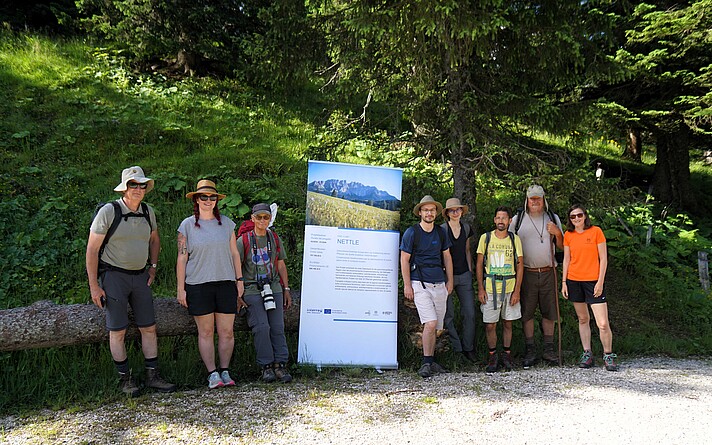What could be more beautiful than collecting the alpine plants that are needed for the extraction in the research project directly from nature? Of course, you first need to know where these plant species grow in sufficient quantities. The best contact point in Salzburg for this is the Botanical Working Group at the Haus der Natur. Thus, our researchers spontaneously joined the excursion "Botanizing in the Border Area" on Saturday, June 29th.

The excursion was led by Dr. Helmut Wittmann, a luminary in the field of botany. The trip took us to the Austrian-Bavarian border area in the Northern Limestone Alps, to the so-called Ahorn-Kaser and the Purtscheller House. According to botanists, the flora in this area is very diverse and hosts rare species such as Alpine flax (Linum alpinum), yellow pea (Lathyrus laevigatus), and Austrian ribseed (Pleurospermum austriacum).
At 8:45, the meeting point and start of the excursion was at the parking lot of the Roßfeldstraße. The two researchers, Anja and Sissy, met with many botanists who were delighted to share their extensive knowledge about the various plant species with them. In exchange, Anja and Sissy told the botanists about the goals of NETTLE and what happens with the plant extracts in the research project. During the excursion, the botanists showed the researchers several plant species suitable for the project. The heat of the day made the hike strenuous: the blazing sun on the mountain, combined with the extensive admiration and examination of countless plant species, drained the energy of the two researchers after about two and a half hours. On the way back, they finally collected three different plant species for the project: woundwort (Anthyllis vulneraria), alpine knapweed (Centaurea montana), and meadow marguerite (Leucanthemum ircutianum). This task kept them busy for a while, as they had to collect almost 2 kg of each plant to obtain 400 g of dry weight plant material. The whole collection effort was not without risks, involving steep mountain meadows and an irate hiker who threatened the researchers with a complaint. Fortunately, they were able to explain the purpose of the plant collection to the lady.
Sissy transported the jute bags full of plant material back to Kuchl and cleaned them, which was quite a dirty job due to the root systems. The material was weighed and placed in the drying cabinet, where it was dried at 30°C with ventilation for a week. Then, the next extraction steps will follow, which are described here.
Next year, we will team up with the botanists again to collect fresh plant material and additionally inform the public about the NETTLE project. Moreover, such excursions are an educational and exciting change from the routine lab and office work in the research project.

